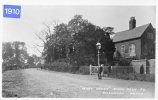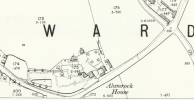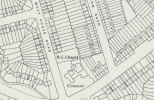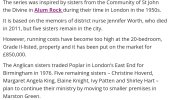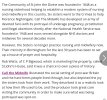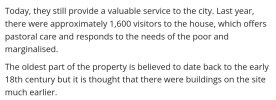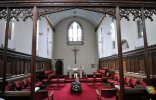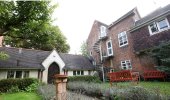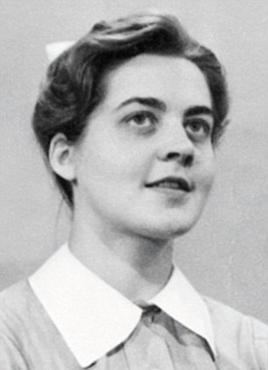-
Welcome to this forum . We are a worldwide group with a common interest in Birmingham and its history. While here, please follow a few simple rules. We ask that you respect other members, thank those who have helped you and please keep your contributions on-topic with the thread.
We do hope you enjoy your visit. BHF Admin Team
You are using an out of date browser. It may not display this or other websites correctly.
You should upgrade or use an alternative browser.
You should upgrade or use an alternative browser.
Moat House, St John's House, Alum Rock/Alumrock House Alum Rock Road
- Thread starter Vivienne14
- Start date
It's St Johns House and it's listed - extract from Historic England below
ALUM ROCK ROAD 1. 5104 Saltley B8 No 652 (St John's House) (the original C18 house only) SP 18 NW 8/1 II 2. Mid C18 house of red brick on an L plan. Two storeys with a 3 bay front to road. Plat band and toothed brick eaves to gable end old tile roof. Broad windows with segmental gauged brick arches, most with late C19 tripartite casements first floor right hand window lengthened early C19 with marginal glazed casement. Another similar window in east gable end. The wing on this side has 2 windows and a gabled dormer. The entrance is also on this side with a doorway of engaged Tuscan columns with sections of entablature supporting the pediment over the semi-circular fanlight. To the west gable end of the main block is a 2 storey brick bow with an ogee arched gothic glazed window on the first floor and a revealed glazing bar sash window to the ground floor. Large C20 neo Georgian additions and chapel excluded from listing.
ALUM ROCK ROAD 1. 5104 Saltley B8 No 652 (St John's House) (the original C18 house only) SP 18 NW 8/1 II 2. Mid C18 house of red brick on an L plan. Two storeys with a 3 bay front to road. Plat band and toothed brick eaves to gable end old tile roof. Broad windows with segmental gauged brick arches, most with late C19 tripartite casements first floor right hand window lengthened early C19 with marginal glazed casement. Another similar window in east gable end. The wing on this side has 2 windows and a gabled dormer. The entrance is also on this side with a doorway of engaged Tuscan columns with sections of entablature supporting the pediment over the semi-circular fanlight. To the west gable end of the main block is a 2 storey brick bow with an ogee arched gothic glazed window on the first floor and a revealed glazing bar sash window to the ground floor. Large C20 neo Georgian additions and chapel excluded from listing.
The 1910 Kellys does not cover that part of Alum roac k Road, as it was not in Birmingham, but the 1912 edition states that it ( no 652 ) was occupied by the Society of the Incarnation, which ios a female Religious order. I am not very knowledgeable about Saltley , but would the house be referred to as Saltley Manor House, as in on the 19.4.1918 the following was published in the Birmingham Mail
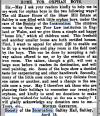

Interesting that on the map it seems to be an RC convent but the article in post #8 refers to Anglican sisters.
yes jan i did not notice that
lyn
Janice,
Ddo you say this because it says "convemt". According to Wikipedia "A convent is a community of monks, nuns, friars or religious sisters. Alternatively, convent means the building used by the community. The word is particularly used in the Catholic Church, Lutheran churches, and the Anglican Communion.[1]"
Ddo you say this because it says "convemt". According to Wikipedia "A convent is a community of monks, nuns, friars or religious sisters. Alternatively, convent means the building used by the community. The word is particularly used in the Catholic Church, Lutheran churches, and the Anglican Communion.[1]"
The late Bill Dargue gives us this history which clarifies some of the background to the site. From manor house, to farmhouse, to Anglican convent and orphanage, to convent of Incarnation, and finally to hub for collaboration between faith interests:
Take a look at Little Bromwich Hall.
At the junction of Alum Rock Road and Moat House Road stands Little Bromwich Hall, the former manor house. The original hall was built here within a moat probably during the 13th or 14th century, though no visible trace of a moat survives. By the 18th century the hall had been rebuilt and was a substantial farmhouse.
It was still known as the Moat House in 1911 when it was converted into an Anglican convent of the Society of the Incarnation of the Eternal Son, a religious order which ran orphanages for boys. A small chapel was built the following year and a small cemetery for members of the order.
After 1959 a new order took over the premises, which are now known as St John's House or the Convent of the Incarnation. Part of the 18th century building survives and is Grade II Listed, though most of the neo-Georgian buildings as seen date from the 20th century. By 2015 the number of nuns at the convent had dropped to five and the building was sold with the sisters moving to premises in Marston Green. St John's House is now St John’s House is the home of a local collaborative initiative, bringing together existing projects and partnering with local churches, charities and other faith groups.
The estate of Little Bromwich first appears in a court case in 1262 in which Thomas de Bromwych sued Robert de Bromwych for the title to the land, his claim based on his descent from Guy de Bromwych who had held it about one hundred years earlier. These Bromwyches derive their surname from Castle Bromwich. John Brandwood was lord of the manor in 1512 and (another?) John Brandwood was lord in 1586. The estate stayed in the family until 1788 when the manor was held by Jane Brandwood. She was succeeded by William Ward in 1797. In 1868 when his estates at Treaford Hall and Alum Rock/ Little Bromwich were sold, it seems that any manorial rights were either lost or had lapsed. By 1658 the name Ward End had probably taken over from Little Bromwich as the name of the manor.
Take a look at Little Bromwich Hall.
At the junction of Alum Rock Road and Moat House Road stands Little Bromwich Hall, the former manor house. The original hall was built here within a moat probably during the 13th or 14th century, though no visible trace of a moat survives. By the 18th century the hall had been rebuilt and was a substantial farmhouse.
It was still known as the Moat House in 1911 when it was converted into an Anglican convent of the Society of the Incarnation of the Eternal Son, a religious order which ran orphanages for boys. A small chapel was built the following year and a small cemetery for members of the order.
After 1959 a new order took over the premises, which are now known as St John's House or the Convent of the Incarnation. Part of the 18th century building survives and is Grade II Listed, though most of the neo-Georgian buildings as seen date from the 20th century. By 2015 the number of nuns at the convent had dropped to five and the building was sold with the sisters moving to premises in Marston Green. St John's House is now St John’s House is the home of a local collaborative initiative, bringing together existing projects and partnering with local churches, charities and other faith groups.
The estate of Little Bromwich first appears in a court case in 1262 in which Thomas de Bromwych sued Robert de Bromwych for the title to the land, his claim based on his descent from Guy de Bromwych who had held it about one hundred years earlier. These Bromwyches derive their surname from Castle Bromwich. John Brandwood was lord of the manor in 1512 and (another?) John Brandwood was lord in 1586. The estate stayed in the family until 1788 when the manor was held by Jane Brandwood. She was succeeded by William Ward in 1797. In 1868 when his estates at Treaford Hall and Alum Rock/ Little Bromwich were sold, it seems that any manorial rights were either lost or had lapsed. By 1658 the name Ward End had probably taken over from Little Bromwich as the name of the manor.
Was the Chapel referred to as RC because of the perception of the Sisters and their work there ? And/or were the Anglican sisters perceived at the time as being closer to Catholicism ? It's a difficult question to solve, as I believe the Sisters became more universal in their faith. This extract from the Community of St John describes the early Sisters (London) as "catholic Anglicans" - with a small 'c' - so presumably they were embracing different aspects of faiths to do their (midwifery) work in the community - if I'm interpreting this sensibly ! But not sure.
Or as has been said, the Chapel wasn't connected. That seems odd if the Chapel was built a year after the Sisters set up their work there. - ie 1912 according to Bill Dargue re post #18.
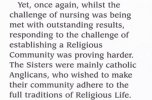
Or as has been said, the Chapel wasn't connected. That seems odd if the Chapel was built a year after the Sisters set up their work there. - ie 1912 according to Bill Dargue re post #18.

Last edited:
jan ive just been on the scottish maps and i am pretty sure i have never seen the option before to see the map dates of 1830 to 1880...wonder if this is another new thing as i usually use the 1880 to 1915 map
Worked on this building in the 70s as a apprentice joiner for Norton ContractorsWas very pleasantly surprised to find this building still exists.
View attachment 193019View attachment 193020
The car park is where we had our site huts you can see the lift shaft put in by us
to the right of the single storey building out of sight was a old over grown grave yard
The building to the right was the oldest part thats where i encounted the oak beams on the top floorFrom the Business Mail dated 2015. The Sisters subsequently moved to Marston Green.
View attachment 193058View attachment 193059View attachment 193060
View attachment 193061View attachment 193062
Radiorails
master brummie
The description of Anglo-Catholic would well fit with the photo shown in post 8, by Vivienne. The chapel has the appearance of a Roman Catholic chapel but close inspection shows a few important items, to Catholics, that are missing. Many Anglican Bishops would not permit certain practices to be allowed as they, presumably did not conform to their 39 articles. I once encountered this attitude in Hereford in the mid 1950's.
Thats about the time i was working thereNot sure how relevant this is but the order of St John the Divine did not move in until 1976. They are the Anglican order linked to "call the midwife"
i can not forget as i completed my apprenticeship and joined the Army as you do
pjmburns
master brummie
True but those photos must be after the order of St John moved in during 1976.The description of Anglo-Catholic would well fit with the photo shown in post 8, by Vivienne. The chapel has the appearance of a Roman Catholic chapel but close inspection shows a few important items, to Catholics, that are missing. Many Anglican Bishops would not permit certain practices to be allowed as they, presumably did not conform to their 39 articles. I once encountered this attitude in Hereford in the mid 1950's.
Even if Anglo Catholic I would not have expected to see RC Chapelon a map (unless they used RC for Religious Community).
Re "Religious Community" That seems very likely Janice. I was wondering in any case, didn't maps around that time used to indicate just 'Roman' if if was Roman Catholic church/chapel and not RC ?
Last edited:
pjmburns
master brummie
I tried to find key for OS maps of the time but the only ones I found all said RC was for Roman Catholic. (Will look later what is says on RC churches and convents I know of).
I just wondered if the RC here was to indicate it wasn't open to a general congregation only the nuns.
The only convent I have been to with a separate chapel is Baddesley Clinton but that is also the local parish so open to all. The convent I went to school at had its Chapel inside the convent - for the nuns only. It was simply one of the rooms in the house the nuns moved into.
Here we have nuns moving in to a large house but having a separate chapel built.
A mystery.
I just wondered if the RC here was to indicate it wasn't open to a general congregation only the nuns.
The only convent I have been to with a separate chapel is Baddesley Clinton but that is also the local parish so open to all. The convent I went to school at had its Chapel inside the convent - for the nuns only. It was simply one of the rooms in the house the nuns moved into.
Here we have nuns moving in to a large house but having a separate chapel built.
A mystery.

